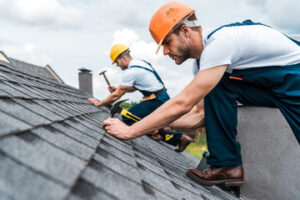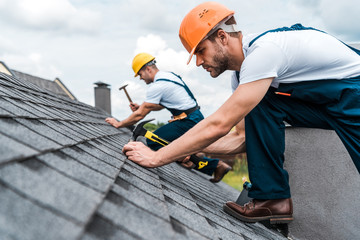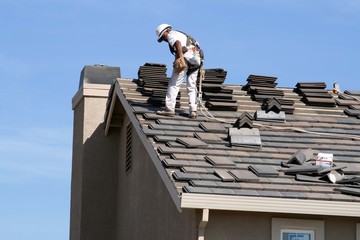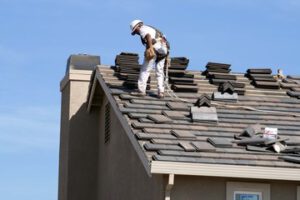Roof Repair NJ is a great way to restore your home’s structural integrity without tearing down and replacing the entire roof. Generally, roofing repairs are focused on repairing leaks and damaged materials.
Checking for water stains on the ceiling is an excellent place to start. Also, look for deteriorating fascia and soffits.
Shingles protect the roof surface, preventing rain and snow from penetrating the structure. When one or more shingles are missing or damaged, it is important to repair them quickly to avoid further damage to the roof. A simple shingle repair can keep moisture and water from causing more serious problems and save you money on expensive repairs to other areas of the house.
Roof shingle repairs are usually done with roofing cement. This is a thick, waterproof sealant that can be applied to the area where the shingle is missing or damaged. This is especially important in the valleys of the roof where water may gather. It can also be used on the edges of the roof near the chimney or vents.
The shingle repair process begins with gathering the necessary materials. A pry bar, hammer, ladder, and utility knife are all required to complete this project. A tool belt is also a good idea to keep all the tools within easy reach. Once the tools are ready, locate the location of the shingle that needs repair and begin to loosen up the nail heads with the pry bar.
Once the nails are loosened, remove the old shingle by pulling it free. It is important not to rip the shingle, as this can cause further damage to the roof and lead to leaks. If a shingle is completely missing, replace it with a new one of the same style and color.
When replacing a damaged shingle, make sure that the front edge is aligned with shingles on either side and that the back edge is covered by a shingle in the row above it. To help prevent leaking, it is recommended that you use adhesive strips along the bottom edge of the new shingle.
It is also a good idea to re-nail the shingle with galvanized roofing nails, hammering against a pry bar placed on the nailheads and under the shingle above (hitting the pry bar with the hammer rather than the shingle). Once the nails are in place, spread a bead of roofing cement over the shingle to help seal it in place.
Flashing
Flashing is the protective metal sleeve installed around protrusions on your roof like chimneys, roof windows and plumbing vent pipes. Its job is to close the gap between your roof and walls or other structures, and keep water from seeping through. Flashing is made from corrosion-resistant sheet metal that can withstand harsh weather conditions, such as dramatic temperature changes. However, if you’re not careful about regular inspections and roof maintenance, flashing can become worn down or damaged, and eventually leak.
One of the most common reasons for a roof leak is because flashing was improperly installed. Ideally, flashing should be properly fitted to ensure there’s no space between the flashing and the roof deck, and it must be tightly sealed with caulking or sealant. A roofer will replace any sections of flashing that are missing or leaking, and also seal the gaps where necessary.
There are several types of flashing to accommodate a variety of situations. Step flashing is most often used around “protrusions” into the roof, such as a chimney or dormer. This type of flashing consists of rectangles of metal bent into an L-shape, and the base of each L is nailed to the roof, while the top is secured to the vertical wall of the chimney or dormer. Continuous flashing is a less common type of flashing, and is usually employed in specialty circumstances such as a valley where two downward slopes meet. Counter flashing is also employed in certain specialized situations, such as when a chimney meets a skylight.
It’s important to know how to identify signs of flashing damage, so you can have it repaired promptly. Signs of deterioration include lifted shingles near flashing, rust or corrosion on the flashing or surrounding caulking, and any areas where the roof appears wavy. In addition, it’s important to make sure that your attic is well ventilated, so any moisture that does leak through the roof doesn’t sit and rot the inside of your home.
If you notice any of the aforementioned warning signs, get up in your attic or crawlspace and examine the flashing for yourself. Take high-resolution pictures of the entire area, and make a list of any spots that look out of place or damp. You can also have a professional roofer inspect your roof and repair any issues that you find.
Gutters
Gutters (also called eavestroughs) are essentially shallow troughs that sit perpendicular to your roof and collect water that falls onto your property. The gutters capture the water and then carry it to a downspout, where the water is directed away from your home. They are a key component in the proper drainage of your roof, and they’re a critical part of preventing the moisture that causes basement rot and mold.
Inspect your gutters for rust, sagging, and debris buildup. Clogged gutters aren’t just an eyesore; they can cause a variety of problems that affect your family’s health and the value of your house.
If your gutters are leaking, look for signs of water damage on the fascia or under the eaves. Leaking gutters are a major source of moisture in the basement, and they can also lead to foundation problems and structural damage to the roof itself.
During your inspection, you should also check the gutters for loose sections and hangers. If you find loose hangers, you can renail them using 6d galvanized roofing nails, then cover the nail heads with roof cement to prevent leaks. If your gutters are sagging, add more supports. They should be spaced about every 21/2 feet along the gutter; if your gutters don’t have enough support, they may collapse or pull away from the house.
Built-in gutters, which are often found on older homes, can be a challenge to maintain. Because they’re concealed from view, they’re easily neglected and can fall victim to a number of problems. Regular cleaning of your built-in gutters is important to keep them free from rust, leaks, and insects.
Soffit
The soffit is the board that covers the underside of your roof overhang. Along with the fascia it helps to maintain attic ventilation and prevent moisture, mold, and rot from damaging your home. It also adds a finished look to your roof overhang. A well-functioning soffit and fascia can help your house stay warm, dry, and comfortable, as well as increase its value and curb appeal.
Both the soffit and fascia are vital parts of your roof structure, but they’re often overlooked. Neglecting soffit and fascia repairs can lead to moisture damage within your attic space, as well as weaken the overall stability of your roof system over time. This is why it’s important to keep an eye out for signs of soffit or fascia damage, such as stains, discoloration, and cracking.
A properly functioning soffit helps to ventilate your attic space and keep moisture from damaging your roof, ceiling, and walls. It can also protect your rafters from the elements and insects. In addition, a soffit can help you save on your energy bills by reducing the amount of heat that escapes from your home in the summer.
Your soffit may be perforated or vented to allow air to circulate in your attic space, which can help avoid moisture and mold build-up. It can also keep the attic cooler in the summer, allowing you to lower your home’s thermostat, and can help prevent ice dams in winter.
In addition to keeping moisture and mold at bay, your soffit can also keep animals and pests from invading your home. If you see gnaw marks or other evidence of animal or pest infestation, you should call a professional for soffit and fascia repair right away.
It is easy to neglect the condition of your soffit and fascia boards because they are not readily visible. However, it is important to inspect your soffit and fascia boards regularly for damage such as rotting or flaking wood, stains, cracks, or peeling paint. This could indicate deeper problems such as wood rot, water penetration, or insect infestation that can cause additional structural damage to your home. If you notice any of these issues, contact a roofer or professional carpenter to provide soffit and fascia repairs.


